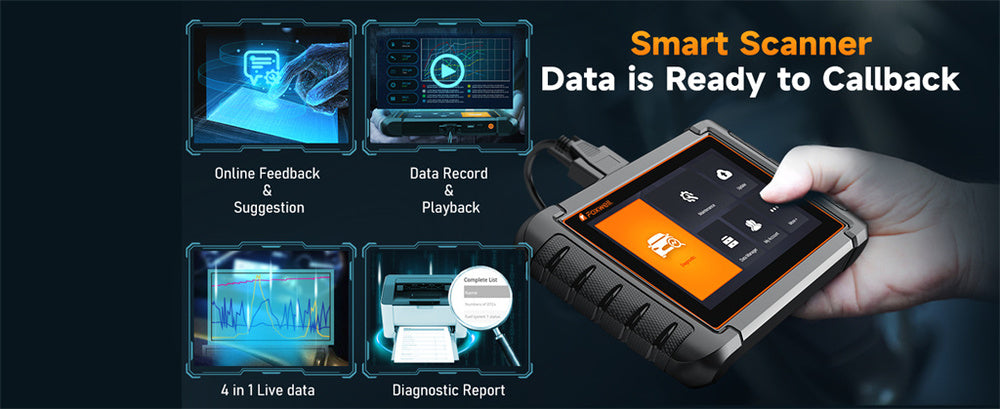Monitoring real-time timing and sensor data to ensure optimal engine performance is at the forefront of vehicle diagnostics today.
Whether you are an amateur or professional mechanic, understanding how your engine functions—down to specific timing issues and sensor readings—is the difference between smooth driving and costly repairs.
Thanks to advanced tools like Foxwell NT710's accurate yet actionable data collection capability, getting accurate readings has never been more accessible, and diagnostics are easily performed.
This article will explain why real-time data and accurate timing are essential in vehicle diagnostics, the features you should look for when purchasing a scan tool like Foxwell's NT710, and how best to utilize them for maximum diagnostic efficiency.
Timing and Real-Time Data Are Vital Components of Vehicle Diagnostics

Precision and real-time feedback are two essential aspects of vehicle diagnostics. Timing refers to the precise moment the spark plug ignites an air-fuel mixture in the combustion chamber.
Any discrepancies could result in reduced performance, misfires, or increased fuel consumption if correct engine timing isn't maintained - incorrect engine timing results in inefficient combustion, lower power output, and decreased fuel economy; for these reasons monitoring and adjusting timing data is one of the primary functions of modern scan tools.
Real-time data provides immediate feedback from sensors throughout your vehicle, such as those monitoring engine temperature, oxygen levels, throttle position, and fuel injection rates.
This can provide more precise diagnostics and faster repairs; combined with timing information, it creates a complete picture of your vehicle's overall health, allowing you to spot potential issues quickly before they grow into more significant problems.
Key Features to Look for in a Scan Tool to Achieve Accurate Timing and Real-Time Data
Selecting an effective scan tool requires prioritizing features that provide precise timing and real-time data, which are vital considerations when searching. Here are the main characteristics you should keep in mind when looking for one:
- Data Precision: An effective scan tool must accurately read sensor data related to engine timing and other performance indicators for optimal engine performance. The more precise a tool is, the easier it can diagnose issues about misfires or incorrect ignition timing.
- Live Data Streaming: Real-time streaming data without significant lag times is crucial to accurately monitoring oxygen sensor outputs, throttle response, or engine RPM and diagnosing issues quickly as they arise.
- OBD2 Compatibility: Confirm that your scan tool supports OBD2 protocols and works with your specific vehicle model. Some tools, like the Foxwell NT710, offer wider compatibility, making accessing diagnostic information across various car makes and models easier.
- Graphing and Logging: Tools that allow you to graph and log real-time data are invaluable for tracking trends and spotting irregularities over time. They enable you to understand better how the engine reacts under various circumstances and catch issues that might not have been apparent during a single scan.
How to Effectively Use a Scan Tool for Timing and Real-Time Data
Utilizing the Foxwell NT710 efficiently requires understanding key data points and taking full advantage of all its features. Begin by paying close attention to ignition timing, engine RPM, and camshaft/crankshaft sensor outputs—parameters the NT710 can monitor.
Doing so allows you to quickly and easily identify issues related to timing, such as misalignments or defects in ignition systems.
Monitor critical sensors in real-time, such as fuel trims, oxygen sensor outputs, and mass airflow (MAF) readings, with the Foxwell NT710 for real-time data streaming.
This provides a window into how your engine responds under various driving conditions, whether idling, accelerating, or driving at highway speeds.
The NT710's graphing feature is particularly effective at visualizing changes in data over time, enabling you to spot trends or abnormalities more efficiently - such as sudden throttle response drops or fluctuating fuel pressure readings more clearly on a graph.
Furthermore, this tool offers recording/logging functionality, useful when diagnosing intermittent issues that only arise under specific conditions.
Tips to Maximize Accuracy with Professional-Grade Scan Tools
Various strategies can be employed to increase accuracy and produce reliable data when using professional-grade scan tools such as the Foxwell NT710.
First, it is essential to ensure your scan tool's software remains up-to-date. Regular updates improve functionality and compatibility with newer vehicle models while increasing data accuracy. Operating on outdated software could result in inaccurate diagnostics or missing critical features.
Once your engine has reached its optimal operating temperature, diagnostics tests are always conducted on it.
Scans performed on cold engines can produce misleading data regarding timing and fuel trims that change as the engine warms. Conducting scans with a warm engine accurately depicts how your vehicle performs under normal circumstances.
Use OEM-specific diagnostic modes whenever possible. Professional-grade tools, like the NT710, offer vehicle-specific diagnostics to give you access to relevant and precise data for your car's make and model. This ensures the most accurate information regarding its make/model combination.
Use live monitoring to monitor your engine's performance while driving. Real-time underload monitoring enables you to observe how timing and sensor data change while accelerating, decelerating, or maintaining steady speeds—something that may not be obvious when the vehicle is stationary. It may help detect performance issues that would not otherwise become evident.
Optimizing Budget-Friendly Scan Tools for Reliable Real-Time Monitoring
When working with budget-friendly scan tools, there are ways you can optimize their performance to provide reliable real-time data monitoring.
One effective strategy is limiting the number of sensors you monitor simultaneously. Budget tools may struggle with processing multiple sensor feeds simultaneously, which could result in slower refresh rates or inaccurate information. Focusing on critical data points like fuel trims and oxygen sensors for reliable feedback may be more productive than simultaneously monitoring multiple data types.
Optimizing performance requires testing your engine under various driving conditions. Some engine issues only manifest during specific driving scenarios, like hard acceleration or higher speeds; use your tool to track how the parameters change under such scenarios.
Constantly update your software - even budget tools can benefit from updating their software to address bugs, improve accuracy and ensure compatibility with more recent vehicles.
Alternatively, consider pairing your budget tool with an external app with graphing or data logging features for improved data analysis. Many budget scan tools support Bluetooth connectivity; pairing this pairing could enhance data tracking and analysis capabilities.

Compelling Scan Tool Use Cases: Timing and Data Analysis
Using a scan tool effectively requires understanding how to apply real-time timing analysis with real-time data analysis on engine issues, such as diagnosing misfires.
Misfires could stem from any number of sources, including spark plugs, ignition coils or fuel delivery issues - by monitoring ignition timing and fuel trim data quickly; your Foxwell NT710 can soon help determine whether its timing issues or an underlying engine component is causing misfires.
One everyday use case is identifying fuel efficiency problems in vehicles. When fuel economy begins to decrease, real-time data from oxygen sensors, MAF sensors, and fuel injectors can reveal inefficiency in how your engine burns fuel - providing accurate insight into any issues with air-fuel mixtures or injector performance that might contribute to increased consumption.
Conclusion
Variable valve timing (VVT) vehicles rely heavily on precise timing to optimize engine performance. Malfunctions in timing solenoids or actuators may lead to rough idling, reduced power, or even engine damage. Using a professional-grade scan tool allows you to monitor timing changes in real-time to detect these problems early and mitigate further harm.
Having a reliable scan tool is paramount to proper vehicle diagnostics and maintaining engine health and performance.
By paying attention to timing and real-time data, you can identify issues before they escalate into more significant issues. Tools like Foxwell NT710 simplify monitoring critical engine parameters, whether dealing with misfires, fuel efficiency concerns, or variable valve timing issues.
Whether you're using an expensive professional tool or a more budget-minded alternative, knowing how to use a scan tool efficiently will save time, money, and frustration. Keep your tools updated with real-time data trends and apply this insight to maintain vehicle performance at its highest levels.
FAQs
What is live data on a scan tool?
Live data on a scan tool refers to real-time information from various sensors in the vehicle, such as engine RPM, fuel trims, and oxygen sensor readings. It allows you to monitor how the vehicle performs under different driving conditions instantly.
Can you check timing with an OBD2 scanner?
Yes, many advanced OBD2 scanners can check ignition timing by reading data from the engine's sensors. This helps diagnose timing-related issues like misfires or incorrect ignition settings.
Which OBD2 mode shows current data?
OBD2 Mode 01 shows current (live) data, including sensor information like engine temperature, RPM, and fuel system status. It’s commonly used for real-time diagnostics.




Leave a comment
This site is protected by hCaptcha and the hCaptcha Privacy Policy and Terms of Service apply.